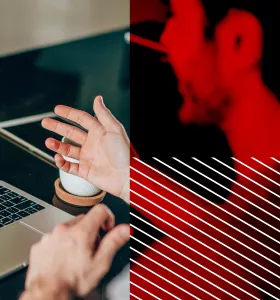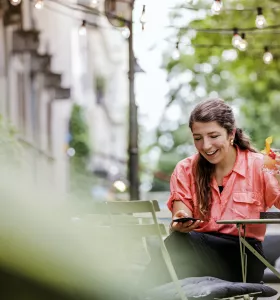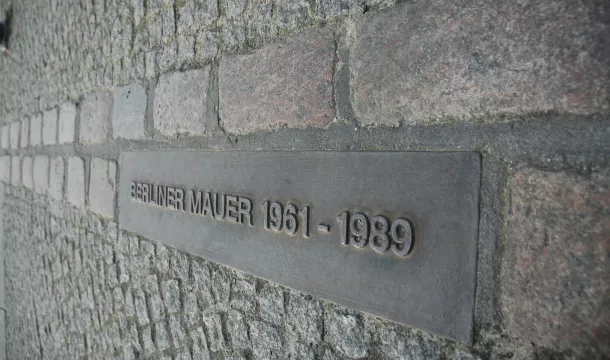The Berlin Wall – Monument and Memorial Site
The building of the Berlin Wall began on 13th August 1961. A symbol of division between a city and a state, of terror and the Cold War. The construction of the Wall changed an entire nation overnight. But Berlin and Germany became united again on 9th November 1989. The Wall, which divided Berlin into East and West for 28 years and tore apart families, friends and neighbours, fell. For many Berliners, this day on which they regained their city and their freedom after a peaceful revolution, was the happiest day of their lives. Today, Berlin is a place of freedom, individuality, and tolerance. And although November 2024 will mark the 35th anniversary of the fall of the Wall, the former division of the city has not lost its relevance. Throughout Berlin, residents and visitors can experience parts of the Berlin Wall even today and go in search of its traces. In the centre of Berlin, a double row of cobblestones represents the former path of the Wall which is wonderful to follow.
The Berlin Wall can be experienced at these places even today
The 1,316 meter-long East Side Gallery in the Friedrichshain district, which is a protected historical monument, is internationally known. The longest section of the Wall, still connected, displays more than 100 works of art. The most frequently photographed motifs probably include Dimitrji Vrubel’s Fraternal Kiss or Birgit Kinders’ Trabant crashing through the Wall.
Also impressive is the The Parliament of Trees on the banks of the Spree, opposite the Reichstag building. The memorial was designed by artist and sculptor, Ben Wagin. He placed altogether 58 original parts of the Wall and parts that he worked on as well as a large number of granite plates carrying the names of the victims of the Wall. A block of 16 trees stands in the centre, which also gives the place its name. The trees represent the 16 federal states of Germany and their reunification.
The Berlin Wall Memorial gives an especially informative and direct impression to visitors. A part of the still-preserved, 70-meter-long former border installation with the remaining piece of the Wall and a watchtower still stands on the former border strip. The “Memorial window” (Fenster des Gedenkens) commemorates all those who lost their lives at the Wall. Anyone who wants to commemorate these victims or take a pause will find a peaceful place in the Chapel of Reconciliation. The permanent exhibition, “1961 | 1989. Die Berliner Mauer” in the Documentation Centre of the Berlin Wall ensemble provides extensive information.
The Invalidenfriedhof (Invalids‘ Cemetery) through which the sector border passed at the time, also lies in Mitte. Around 180 metres of the former Hinterland wall (inner wall) are still preserved in parts today. Just a few meters away, the Günter Litfin Memorial commemorates the refugee of the same name, the first victim of the Wall. Despite extensive construction work, the former watchtower from which the shots used to be fired is still standing today and allows visitors to get a view from the perspective of the border officials at the time.
Another protected historical watchtower is located on the Erna-Berger-Strasse, in the close surrounding of Potsdamer Platz. Anyone halting here should also visit the “Die Mauer I The Wall” museum on the neighbouring Leipziger Platz. Relics from this period in particular are exhibited, showing exactly where the Wall used to be located.
On the tracks of the Berlin Wall
For all those who want to go deeper into the subject of the Berlin Wall and the division of the city, a visit to the privately run Mauermuseum Haus am Checkpoint Charlie (Wall Museum) at the border crossing of the same name is recommended. Founded in 1962, it was the first of its kind and, in addition to a permanent exhibition on the history of NATO, first and foremost shows original escape objects from that period – including a self-made hot-air balloon and a mini submarine. But what did Berlin actually look like when it was divided? An answer to this question is provided by Yadegar Asisi’s “Die Mauer –The Asisi Panorama of the divided Berlin", an artist who grew up in the GDR. A 270° panorama shows an apparently normal autumn day in Berlin in the 1980s. However, in combination with an impressive musical backdrop, films and voices of contemporary witnesses, it quickly becomes clear how life was at the time - far from normal, and in fact, terrible. BlackBox Cold War on the opposite side of the street shows what effect the building of the Wall had on Germany and on the rest of the world.
The permanent exhibition “GrenzErfahrungen. Alltag der deutschen Teilung” (Border Experiences. Everyday Life in Divided Germany) in the former check-in hall, Tränenpalast, which is located at Friedrichstrasse Station, provides another glimpse into life at the time. Anyone who used this official route to the West or one of the many illegal escape routes often landed up in Marienfelde, a refugee transit camp. Altogether 1.35 million people found refuge here. How they got there and what their lives were like can be seen today at the Marienfelde Refugee Center Museum.
Of course, you also have the option of booking one of the many guided tours on the subject of the Berlin Wall and the divided city – or using the free app ABOUT BERLIN. At more than 200 places, it tells stories that will be at your fingertips. One of them is that of Peter Schulenburg, a West Berliner who along with 34 friends built a tunnel 12 meters deep and 145 meters long, which gave a glimmer of hope to many people. The app shows how many of them succeeded and what hardships they had to endure. The stories from that time became all the more real with the virtual reality journey through time called "TimeRide".
The Wall around West Berlin was altogether 156.4 kilometres long. The Berliner Mauerweg (Berlin Wall Trail) covers this entire route and is ideal for exploring by bike or on foot. Special individual routes measuring between 7 and 21 kilometres have been constructed for this reason. Almost 40 kilometres of the wall were built in the city centre. Geschichtsmeile Berliner Mauer (Berlin Wall History Mile), a permanent exhibition in four languages, offers 31 different stations along this route, where visitors can get more information on this topic.





